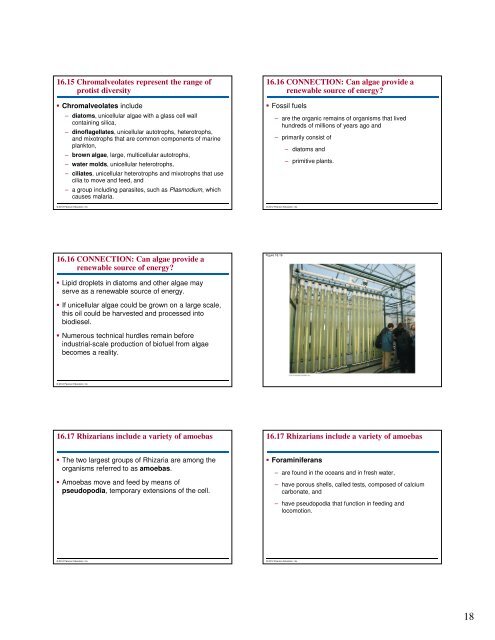Microbial Life: Prokaryotes and Protists - Renz Science
Microbial Life: Prokaryotes and Protists - Renz Science
Microbial Life: Prokaryotes and Protists - Renz Science
You also want an ePaper? Increase the reach of your titles
YUMPU automatically turns print PDFs into web optimized ePapers that Google loves.
16.15 Chromalveolates represent the range ofprotist diversity Chromalveolates include– diatoms, unicellular algae with a glass cell wallcontaining silica,– dinoflagellates, unicellular autotrophs, heterotrophs,<strong>and</strong> mixotrophs that are common components of marineplankton,– brown algae, large, multicellular autotrophs,– water molds, unicellular heterotrophs,– ciliates, unicellular heterotrophs <strong>and</strong> mixotrophs that usecilia to move <strong>and</strong> feed, <strong>and</strong>– a group including parasites, such as Plasmodium, whichcauses malaria.16.16 CONNECTION: Can algae provide arenewable source of energy? Fossil fuels– are the organic remains of organisms that livedhundreds of millions of years ago <strong>and</strong>– primarily consist of– diatoms <strong>and</strong>– primitive plants.© 2012 Pearson Education, Inc.© 2012 Pearson Education, Inc.16.16 CONNECTION: Can algae provide arenewable source of energy?Figure 16.16 Lipid droplets in diatoms <strong>and</strong> other algae mayserve as a renewable source of energy. If unicellular algae could be grown on a large scale,this oil could be harvested <strong>and</strong> processed intobiodiesel. Numerous technical hurdles remain beforeindustrial-scale production of biofuel from algaebecomes a reality.© 2012 Pearson Education, Inc.16.17 Rhizarians include a variety of amoebas16.17 Rhizarians include a variety of amoebas The two largest groups of Rhizaria are among theorganisms referred to as amoebas. Amoebas move <strong>and</strong> feed by means ofpseudopodia, temporary extensions of the cell. Foraminiferans– are found in the oceans <strong>and</strong> in fresh water,– have porous shells, called tests, composed of calciumcarbonate, <strong>and</strong>– have pseudopodia that function in feeding <strong>and</strong>locomotion.© 2012 Pearson Education, Inc.© 2012 Pearson Education, Inc.18


